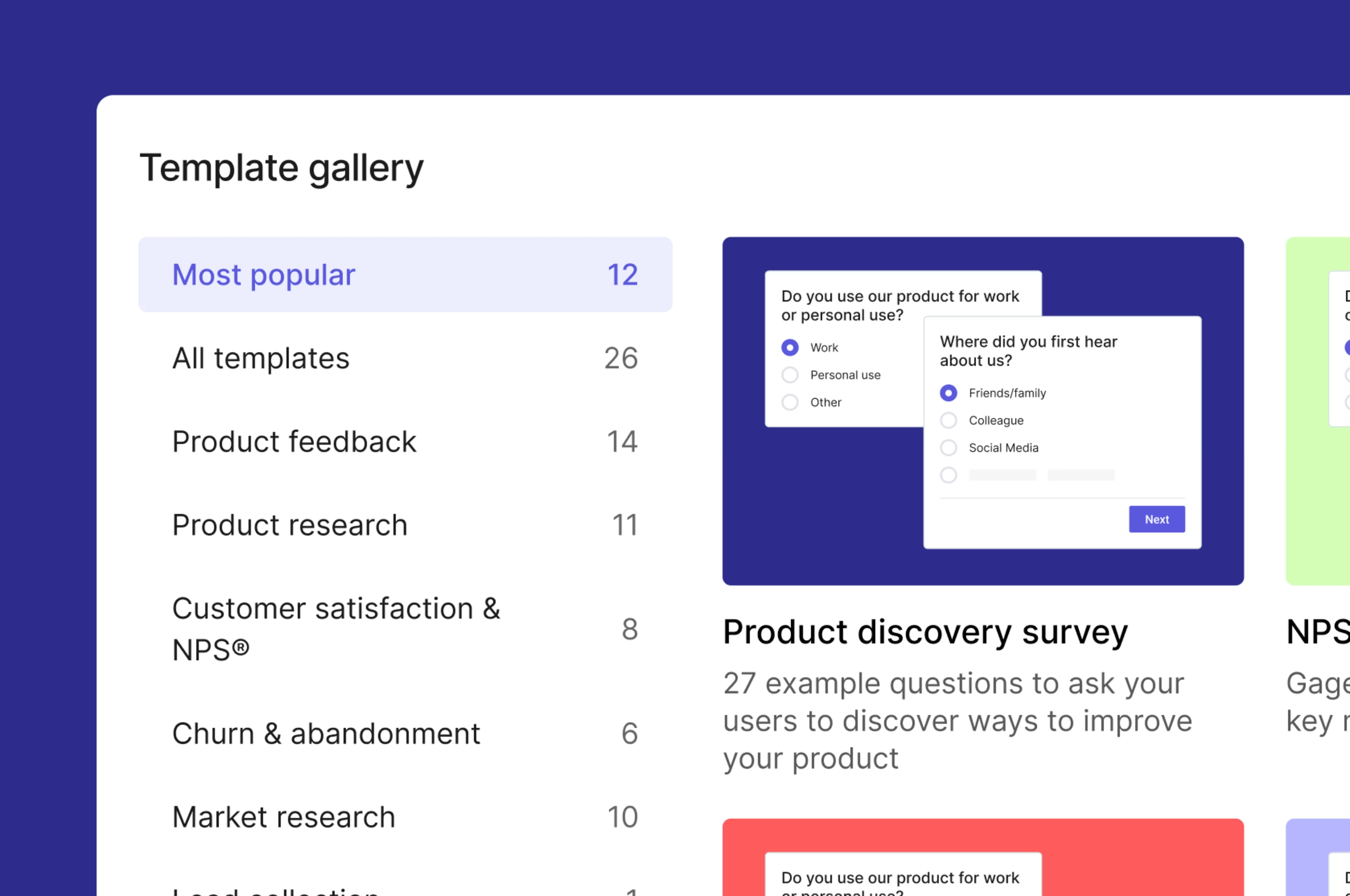Though each survey has its own unique set of goals, all successful surveys share one aspect: they provide you with actionable insights.
Creating your survey with thought and intention sets you up to understand
What your users like and don’t like
What their goals and challenges are
What they want, need, and expect from your product or service
How you can change or improve your product to give them a better experience
This guide chapter shows you 4 easy steps to create effective online surveys that give you actionable user data by setting clear goals, asking the right questions, then building and launching your survey to maximize results.
Instead of trying to get the highest number of responses possible, design your survey to provide value to your users: aim to find the highest quality information that helps you help them.
An effective survey creation process follows these 4 simple steps:
Set an achievable goal
Write questions that strike a balance between getting enough information without overwhelming your respondents
Design your survey
Launch and distribute it at the appropriate place and time
1. Set your survey goal
Knowing what you want to accomplish with your survey informs the questions you ask and, in turn, helps you collect actionable user data.
To understand what your survey goal(s) could be, ask yourself
What are the questions I want to answer or the problems I need to solve for my users?
What do I want to learn about the user experience?
How am I going to use the data I collect from this survey?
Having a specific survey goal in mind enables you to zero in on relevant customer feedback and iterate on certain data variables.
![[Visual] AI survey > survey goal](http://images.ctfassets.net/gwbpo1m641r7/2YHLhJlL1JQqhMWO0gMYyr/d8003cbda13fd6bf1932a1f98ae7aa8f/VoC_-_Create_a_survey_with_AI.png?w=1920&q=100&fit=fill&fm=avif)
Build a survey for any goal with Contentsquare’s intuitive survey maker
Start building your survey around goals to
Facilitate product development: gain immediate feedback once you implement a change, then recruit respondents to participate in further user tests to be confident in your product decisions
Improve the customer experience (CX): target surveys to specific customer segments to tailor your CX to the needs of each segment
Measure customer satisfaction: monitor customer satisfaction and retention rates with a Net Promoter Score® or exit-intent survey to gauge loyalty and success, then increase satisfaction to facilitate long-term business growth
Validate ideas with user testing: survey your target audience to validate variations of your designs, user interfaces, or content so you know exactly how to improve the usability or relevancy of your website and products
The more specific your goal, and the more direct your survey questions, the more actionable your survey results will be. What (and who) to ask becomes much clearer with a particular purpose in mind—don’t just set out to understand your users, set out to understand why these users act a certain way on your pages.
💡Pro tip: if you need some inspiration, look out for surveys on the websites you visit yourself (this is also a good chance to note elements that catch your eye so you can write and build your own survey when the time comes).
Look at what’s asked of you and consider why you’re being asked that question and what insights your answer may bring—that’s a survey goal in action. Do this a few times to get some ideas, then go to the drawing board.
2. Write your survey questions
We cover this step at length in Chapter 2, going over different survey question types and examples, but it doesn’t hurt to recap some best practices for writing survey questions.
No matter what you end up asking, try to keep your survey short and to the point to increase your response rate. Think of the one question best suited to get survey results that align with your goal, whether that’s a single multiple-choice, yes/no, or open-ended question.
If you want to ask a somewhat longer questionnaire, make sure to balance closed-ended with open-ended questions. Consider posing a simple multiple-choice question to attract respondents, then follow up with a free-response question to gain more context.
![[Visual] Exit-intent survey](http://images.ctfassets.net/gwbpo1m641r7/70LxdbnLg3vHHjjMfZjfmb/ae68013aad3713169bfcac7b7ab1c795/image3.png?w=1920&q=100&fit=fill&fm=avif)
A close-ended question (like the ones above) provides people with choices to answer from, whereas an open-ended question requires respondents to type their answer in their own words
💡Pro tip: write your survey questions based on your goals and tailor your language to the user segment(s) you want insights from. To personalize the customer experience, think about how to phrase your questions for new vs. returning users, paying customers, users with a specific lifetime value, and users from a specific industry or region. Also, keep traffic sources in mind and write questions to survey different segments that come from social media, organic search, and word of mouth.
Use Contentsquare’s AI assistant to write survey questions
Contentsquare saves you time when it comes to writing goal-based survey questions—use Voice of Customer’s intuitive, AI-powered survey tool with advanced targeting options to create surveys. Simply type in your goal and our AI technology will write the questions for you.

Contentsquare’s AI-powered Voice of Customer lets you write a survey in seconds
💡 Pro tip: get the full picture with Contentsquare’s Experience Analytics tools and let user data guide your survey questions.
Spot user behavior trends with Journeys (to follow the path users take through your site, from entry to exit) and Heatmaps (to see how users engage with certain elements on a page), then launch a survey to uncover the why with questions that get to the bottom of behavior.
3. Design your survey
Once you know what you’re asking, and why, it’s time to create your survey. A good survey leverages format and design to achieve optimal results.
Your survey format depends on your goal, as well as the amount and type of question(s) you want to ask. If you’re looking for a high volume of quick user insight, use Contentsquare to embed a one-question feedback button throughout your site. For more in-depth data collection, create a multi-question link survey on a stand-alone page and send it to your most loyal followers via social media or email.
Choose one of the following types for your own survey:
Pop-over: pop-up widget at the bottom of a website page
Button: an integrated, customizable button
Bubble: an unobtrusive, chat-like response bubble
Embedded: questions placed in line with page content
Overlay: an overlay window that covers site content
Link: a stand-alone page, sent via email or shared on social media
![[Visual] Create a survey > survey type](http://images.ctfassets.net/gwbpo1m641r7/6DNogHwi8A7exEZvCcdIky/b3b4b725cb6c7f692f2753cc745c0ef8/10.png?w=3840&q=100&fit=fill&fm=avif)
Choose your survey type with Contentsquare
After you decide on a format and populate your survey with questions, customize its design, language, and appearance on the page. Incorporate your branding and add your logo, or play around with the background and font colors—a nice look and feel attracts more survey respondents.
Survey design doesn’t have to be too complicated: choosing even one or two colors that match your branding reinforces the legitimacy of your survey, signaling that you put real thought into it.
![[Visual] Create a survey > appearance](http://images.ctfassets.net/gwbpo1m641r7/37zeEmSsiYqAEPpJKeZz5f/7276e7b021d60572f8d369d50359bff1/survey_appearance.png?w=3840&q=100&fit=fill&fm=avif)
Contentsquare’s Voice of Customer has built-in survey customization
Customize Contentsquare’s pre-built survey templates to save time
Creating a new survey from scratch is rewarding, but if you’re pressed for time or don’t really know where to start, try building your survey from a template.
Contentsquare Surveys provides you with over 40 expert-built templates that you can easily add questions to or customize with your own language and branding.
Take a tour of how to create your own
Net Promoter Score® (NPS®) survey, to see if customers would recommend your business to others, indicating a measure of success
Exit-intent survey, to understand why people exit certain pages
Feedback button, to gather continuous user data that you can filter and compare over time
And more!
4. Launch your survey
So you’ve set your goal, written your questions, and built a survey that you’re happy with. Now you need to distribute it in a way that gets people to participate and provide you with the actionable data you're after.
Here are some ideas of where and when to place your survey to maximize results.
Where to display your survey
Trigger a display on your landing page that entices users to engage (for example, offer them a new customer discount if they answer a simple question)
Display a corner pop-over on pages with high exit, bounce, or churn rates to ask visitors what’s confusing or missing for them
Create a CTA button that sends visitors to sign up for your contact list, then email them a survey about their experience or likelihood to recommend your business
Post your survey on social media, or create unique survey links for your brand ambassadors and have them share the survey with their network
When to display your survey
Immediately after the page loads
After a delay of x amount of time
When a user scrolls halfway down the page
Before a user abandons the page (when they mouse toward the top of the browser on a desktop device)
💡Pro tip: with Contentsquare, you can distribute your survey at the most appropriate time and place while users interact with your site or brand to get valuable, in-the-moment feedback while the experience is still fresh in their minds.
Use Contentsquare to analyze your survey results
Of course the last step is analyzing your survey responses—we cover this in the next chapter. Following the above steps sets you up for getting user data that enables you to identify and take actions that help your users achieve their goals.
Contentsquare’s AI-powered summary reports, with built-in response tagging and sentiment analysis, provide a great starting point for expanding your survey insights.
What comes next?
You made it! Well, not quite...
To become even more confident in your findings, combine survey insights with comprehensive data gained from experience analytics tools.
Let’s say your survey uncovers pain points in your checkout flow and you determine that one way to improve the user experience involves shortening your form fields. Behavior data from Contentsquare tools like Journeys, Session Replay, and Heatmaps reveal key mouse movements and flow information that captures how users behave, both before and after you implement an optimization. Compare metrics and run another survey to see if things have indeed improved, or go a step further and use Interviews to follow up with your users at length.

![[Visual] Contentsquare's Content Team](http://images.ctfassets.net/gwbpo1m641r7/3IVEUbRzFIoC9mf5EJ2qHY/f25ccd2131dfd63f5c63b5b92cc4ba20/Copy_of_Copy_of_BLOG-icp-8117438.jpeg?w=1920&q=100&fit=fill&fm=avif)